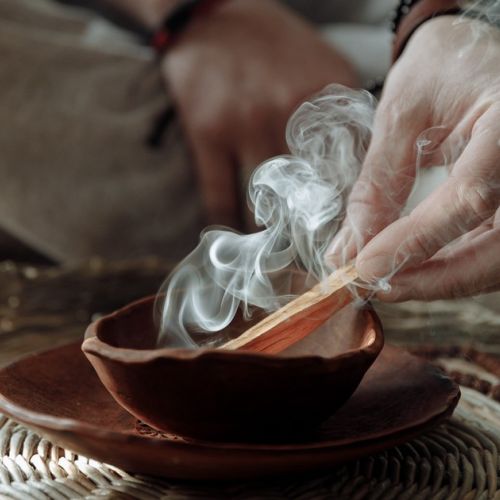Often used as an offering to gods and goddesses, incense also allows for the practice of a fumigation ritual called smudging. We invite you to discover why and how to burn incense, herbs, or sacred wood.

Often used as an offering to gods and goddesses, incense also allows for the practice of a fumigation ritual called smudging. We invite you to discover why and how to burn incense, herbs, or sacred wood.

Smudging is a ritual that many people consider to be magical or sacred. It involves practicing a fumigation to purify one's environment or purify oneself.
This ancient practice exists in many cultures for centuries. It can have different objectives such as:
• purifying the environment and masking bad odors
• making offerings to gods and goddesses
• creating a pleasant atmosphere conducive to the practice of meditation and yoga
• releasing the magic contained in herbs or resins by burning them.
To practice smudging or fumigation, different types of natural materials can be used:
• resins such as incense, myrrh, and benzoin resin
• woods like palo santo (a sacred wood from the South American tree Bulnesia sarmientoi), sandalwood, or cedar
• barks such as cinnamon sticks
• herbs like rosemary, sage, and sweet grass.
These various ingredients can be easily found in herbal shops and esoteric stores. If you are new to this practice and don't know what to choose for your first fumigation, know that each ingredient is believed to have specific properties.
Incense and myrrh, which were among the gifts of the Three Wise Men in the Bible, are considered sacred. In hatha yoga, it is said that the smoke of these two resins helps to calm the mind and align the chakras. Therefore, you can use them for fumigation in a room before a yoga or meditation session.
Palo santo is traditionally used by shamans to eliminate negative energy from a place and attract love and prosperity. Its woody fragrance has the properties to:
• purify a place or an object
• enhance concentration and the practice of mindfulness meditation.
Sage is one of the most commonly used medicinal herbs for purifying fumigation, either in a room or on oneself. When burned, it generates negative ions that refresh the atmosphere. If you want to cleanse your body and mind, you can burn sage and pass the smoke over the palms of your hands, under your arms, and under your feet.
Sweet grass (botanical name: Hierochloe odorata) is a sacred herb sometimes called "Mother Earth's hair" because it is associated with feminine rituals. When burned, it releases a slightly sweet and vanilla-like fragrance believed to bring serenity, kindness, and spiritual healing. It not only allows purification but also attracts beneficial energies to a place.
The first method to know for practicing smudging is to make a smudge stick, which is a small bundle. Gather leafy stems (such as sage and rosemary) into a bouquet and tie them together with natural twine. Let the smudge stick dry for several weeks in a dry place. This drying step is essential for the smudge to burn smoothly and evenly.
When the stick is completely dry, simply light one end with the flame of a candle or match. Wave the smoke around yourself in the area you wish to purify. This smudging method is safe as the stick will extinguish on its own after a few minutes.
The second method of smudging involves directly burning herbs or resin of your choice on a lit charcoal, placed on a heat-resistant surface like a scallop shell or a small censer.
Regardless of the chosen method, always handle the flame of the match or candle with caution.